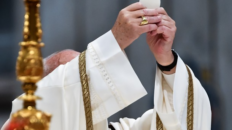On “the day the sun danced,” thousands of people bore witness to a miracle that not only proved the validity of the Fatima Marian apparitions but is also said to have shattered the prevalent belief at the time that God was no longer relevant.
What crowds witnessed the day of the miracle was “the news that God, in the end, contrary to what was said in the philosophy books at that time, was alive and acting in the midst of men,” Dr. Marco Daniel Duarte told CNA in an interview.
If one were to open philosophy books during that period, they would likely read something akin to the concept conceived by German philosopher Friedrich Nietzsche, who died in 1900 and boldly made the assertion in his 1882 collection “The Gay Science” that “God is dead.”
Yet as this and other philosophies like it were gaining steam in the life and thought of society, the Virgin Mary appears and tells three small shepherds that “God is alive and still attentive to humanity, even though humanity is waging war with one another.”
Duarte, a theologian, and director of the Fatima shrine museums, spoke about the cultural significance of the Miracle of the Sun given the atheistic thought prevalent in Portuguese society at the time.
In 1917, Portugal, like the majority of the world at the time, was embroiled in war. As World War I raged throughout Europe, Portugal found itself unable to maintain its initial neutrality and joined forces with the Allies, in order to protect colonies in Africa and to defend their trade with Britain. About 220,000 Portuguese civilians died during the war; thousands due to food shortages, thousands more from the Spanish flu.
Compounding the problem, government stability in the country had been rocky at best following the revolution and coup d’etat that led to the overthrow of the monarchy and subsequent establishment of the First Portuguese Republic in 1910.
A new liberal constitution separating Church and state was drafted under the influence of Freemasonry, which sought to omit the faith – which for many was the backbone of Portuguese culture and society – from public life.
Anti-Catholicism in Portugal had initially begun in the 18th century during the term of statesman MarquĂŞs de Pombal and flared up again after the drafting of the new constitution.
Catholic churches and schools were seized by the government, and the wearing of clerics in public, the ringing of church bells, and the celebrating of popular religious festivals were banned. Between 1911-1916, nearly 2,000 priests, monks, and nuns were killed by anti-Christian groups.
This was the backdrop against which Mary, in 1917, appeared to three shepherd children – Lucia dos Santos, 10, and her cousins Francisco and Jacinta Marto, 9 and 7 – in a field in Fatima, Portugal, bringing with her requests for the recitation of the rosary, for sacrifices on behalf of sinners, and a secret regarding the fate of the world.
To prove that the apparitions were true, Mary promised the children that during the last of her six appearances she would provide a “sign” so people would believe in the apparitions and in her message.
What happened on that day – Oct. 13, 1917 – has come to be known as the “Miracle of the Sun,” or “the day the sun danced.”
According to various accounts, a crowd of some 70,000 people – believers and skeptics alike – gathered to see the miracle that Mary had promised. After appearing and speaking to the children for some time, Mary then “cast her own light upon the sun.”
The previously rainy sky cleared up, the clouds dispersed and the ground, which had been wet and muddy from the rain, was dried. A transparent veil came over the sun, making it easy to look at, and multi-colored lights were strewn across the landscape.
The sun then began to spin, twirling in the sky, and at one point appeared to veer toward earth before jumping back to its place in the sky.
Duarte said the miracle was direct, and very convincing contradiction to the atheistic regimes at the time, which is evidenced by the fact that the first newspaper to report on the miracle was an anti-Catholic, Masonic newspaper in Lisbon called O Seculo.
The Miracle of the Sun, he said, was understood by the people to be “the seal, the guarantee that in fact those three children were telling the truth.”
Even today, “Fatima makes people change their perception of God,” he said, explaining that for him, one of the most important messages of the apparitions is that “even if man has separated God from his existence, God is present in human history and doesn’t abandon humanity.”
With World War I raging, a war the likes of which the world had never seen, Mary appeared to tell the children that “that story can have another ending when the power of prayer is stronger than the power of bullets.”
The Miracle of the Sun is also the heart of a special exhibition called “The Colors of the Sun” the shrine is offering for the duration of the centenary year of the apparitions, which focuses on the symbolic nature of the miracle and its cultural significance.
Displayed are “various objects, some older, others more contemporary, some more modern, some made of textile, others of organic materials, paintings, sculptures,” but which are all “placed with a narrative,” he said.
Beginning with a set of black umbrellas used by people who had gathered at the Cova de Iria (Cave of Iria) where Mary appeared Oct. 13, the exhibit aims to build a narrative of what people saw that day, and is supplemented with different works that express the various elements of Mary’s message to the children.
It also shows developments of how the shrine developed over the years, showing the transformation of what used to be a small, simple chapel into what is now two basilicas: the Basilica of Nossa Senhora do Rosario (Our Lady of the Rosary) and Basilica da Santissima Trindade (Basilica of the Holy Trinity), with an open chapel in between where the statue of Our Lady of Fatima resides.
Pieces come from all over the world – some from the Fatima shrine, some from the State of Portugal, and some even hail from Germany and France.
One of the highlight pieces is a giant heart made by Joana Vasconcelos, a well-known Portuguese artist who crafted the piece entirely out of red plastic ware, such as spoons and forks.
“It’s material that isn’t important for anyone, but which after everything is united, forms the image of a heart and can be the image of reparation,” Duarte said.
The exhibit closes with white parasols, rather than umbrellas, in order to show the fruit of the miracle, Duarte said, adding that it can also signify “the presence of God, the Eucharistic Christ.”
In this sense, the parasols “can be for us a symbol that also we can be God’s tabernacles and can be the place where God dwells,” he said. “This is the true shrine that God wants. The shrine of Fatima is precisely the image of what God wants: to dwell among men.”






Add comment